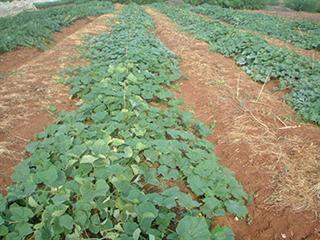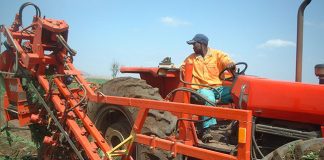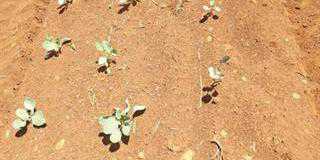
For one thing, you have to remember that plants must have enough fruit set and developing on the vines before leaf growth ‘closes up’ the area, leading to fruit abortion. Therefore you have to consider the factors which limit the amount of fruit set per variety before this stage.
Timing
The time of the year is important here. In cooler conditions where the days are shorter, the plant will set fruit much closer to the crown than in midsummer. This is especially so in frost-free areas in winter. Here, the first female fruit may be set 40cm from the crown, whereas it may be 150cm from the crown with the same variety later on. Clearly, you’ll be able to space your rows a lot closer together in the cooler months. Even in frosty areas limited to summer production, there will be some difference between planting just after the last frosts, compared to midsummer. In addition, the internodes will be shorter in cooler conditions, and this will influence the positioning of the next fruit.
Soil fertility
Soil fertility will also play a role. In less fertile conditions, the plant will tend to be more compact with smaller leaves and shorter internodes, and more fruit will be set before the plants close up than in lush, fertile conditions. I’ve often come across disgruntled farmers who’ve provided the best possible conditions only to find that their neighbour, who’s neglected his crop, gets a higher yield. It’s only when you understand these principles that you’ll consistently reach maximum potential.
A pumpkin may set its first fruit 1,5m from the crown and then set the next lot much closer than the first.
This is where, in many cases, you can get better yields by wider spacing. The same variety may give the best yields from rows 2m to 5m apart, depending on the factors we’ve discussed. But rather err on the side of wider spacing. Different varieties require different spacing. Runners such as Boer pumpkins tend to set their first fruit much further from the crown than the grey types, and this needs to be taken into account. We can’t generalise.
The semi-bush compact types produce their first fruits close to the crown and may abort a number of subsequent fruits until the plant has generated sufficient leaves to start setting again. It’s often better that the first fruit isn’t set too close to the crown, as the variety may set the next fruits close to the first in this case. You need to use experience and observation with every variety to get the best spacing for that variety.
Compact types may set one or two fruit fairly close to the crown and then set the next round of fruit some distance from the first. It might pay to plant the rows far enough apart so as to gain the maximum fruit from the area rather than from each plant. You may therefore target the first fruit set only by closer row spacing.
Row spacing
You also have to consider the spacing in the row. This too will vary from variety to variety and type to type. Some farmers feel that spacing at equal distances from each direction will provide the best results, but this isn’t always the case. Even having plants touching each other isn’t too serious, as long as there’s still open ground between the rows to encourage the plants to continue setting fruit.
With compact growers, the spacing in the row can be especially important, as this may determine whether the plants set one or two fruit close to the crown for that particular variety. Clearly, the closer you can go to achieve the maximum fruit set will have a profound influence on the overall yield. These recommendations are merely intended as a starting point. Ultimately, it’s best to run trials with each planting to determine the formula which works best for you.













